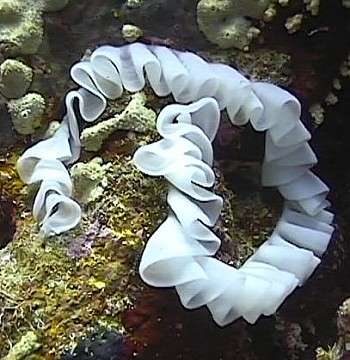Spanish Dancer with white eggs?
April 6, 2000
From: Jan Reyniers

Hello ,
After visiting your webside I have a question about the Spanish Dancer eggs.
On my last trip to Egypt, [Ras Mohammed, Sinai], I found some eggs of a Spanish Dancer?? The only problem with these eggs is
that they are WHITE. Can you give me more information , or is this normal?
I've dived there for more than 300 times and this was the first time I saw them in this white colour. Or are they from another animal. The Depth was 18 meter and the egg-ribbon was about 30 cm in diameter.
Greetings,
Jan Reyniers
jan.reyniers@pandora.be
Reyniers, J., 2000 (Apr 6) Spanish Dancer with white eggs?. [Message in] Sea Slug Forum. Australian Museum, Sydney. Available from http://www.seaslugforum.net/find/2217Dear Jan,
From my own experience and from the literature (Gohar & Soliman - Red Sea; Francis - West Pacific), Hexabranchus sanguineus, the Spanish Dancer, has an egg ribbon which is bright pinkish red when laid, and changes to a reddish brown colour before hatching.
As you didn't see who produced the eggs and suggestion of mine is going to be a bit of a guess. My bet is that they are probably the eggs of Pleurobranchus forskalii. There is a photo of a section of its egg mass in the Forum. Apart from the similarity in shape, there are not many opisthobranchs large enough to produce an egg ribbon of 30cm diameter. I have seen shallow lagoons in Tanzania festooned with masses of P. forskalii produced by dense aggregations or assemblies of breeding adults all about 10cm long. Although the egg ribbons were often tangled, some isolated ones were more than 10cm in diameter. As Pleurobranchus forskalii can grow to about 30cm I assume it could produce an egg ribbon of similar diameter.
But I must warn you this is only an educated guess. I would welcome any more interesting finds you would like to share with us.
Best wishes,
Bill Rudman.
References:
•Francis,MP (1980) Habitat, food and reproductive activity of the nudibranch Hexabranchus sanguineus on Tongatapu Island. The Veliger 22(3): 252-258. (Figs 1-4)
•Gohar,HAF; Soliman,GN (1963) The biology and development of Hexabranchus sanguineus (Ruppell & Leuckart) (Gastropoda, Nudibranchiata). Publications of the Marine Biological Station, Al-Ghardaqa, Egypt, 12: 219-247.
Related messages
-
Pleurobranchus forskalii from Singapore
From: Ron Yeo, March 28, 2008 -
Pleurobranchus forskalii from Indonesia
From: Mirjam Broos, February 15, 2007 -
Swimming Pleurobranchus
From: Mark Schaer, June 20, 2006 -
A pleurobranch from Saipan
From: Takao Urasawa, August 19, 2005 -
Re: Mystery slug from Malaysia
From: Jimmy Goh, May 10, 2005 -
Large pleurobranch from Malaysia
From: Alphonsus Jude Joseph, April 28, 2005 -
Is this a sea slug?
From: Dominic Rutherford, February 2, 2005 -
Pleurobranchus forskalii from Lizard Is
From: Nils Anthes, January 10, 2004 -
Pleurobranchus forskalii from Sabah
From: Asther M. Lau, July 23, 2003 -
Pleurobranchus forskalii from South China Sea
From: Audrey Koh, May 9, 2003 -
Re: Mystery slug from Malaysia
From: Michael Smith , March 27, 2003 -
Mystery slug from Malaysia
From: Michael Smith, March 26, 2003 -
Pleurobranchus forskalii from Lord Howe Island
From: W.B. Rudman, January 28, 2003 -
Pleurobranchus forskalii from Solomons
From: Bruce Potter, July 14, 2002 -
Pleurobranchus forskalii from South Africa
From: Valda Fraser, January 3, 2001 -
Pleurobranchus synonyms in South Africa
From: Ernest C.J. Seamark, June 17, 2000 -
Re: Notaspidean defensive secretions
From: Bill Rudman, May 14, 1999 -
Pleurobranch acid secretions
From: Rhanor Gillette, May 6, 1999 -
Skin secretions in Pleurobranchus forskalii
From: Clay Bryce, April 30, 1999 -
Pleurobranchus forskalii, P. peroni
From: K. Koyanagi, April 29, 1999 -
Pleurobranchus forskalii in South Africa
From: Ernest C.J. Seamark, April 17, 1999 -
Opisthobranchs from Durban, South Africa
From: Ernest Seamark, March 13, 1999
